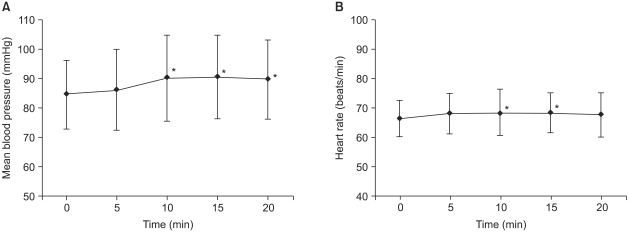1. Song SO, Jo YW. Effects of the volume of local anesthetic used in stellate ganglion block on the elevation of skin temperature of ipsilateral upper extremity. Korean J Anesthesiol. 1999; 37:233–239.

2. Seo YS, Kim SH, Hur CR, Lee KJ, Lee SY, Kim CH, et al. Changes in blood flow velocity of middle cerebral artery after stellate ganglion block. Korean J Pain. 1996; 9:57–62.
3. Patel PM, Drummond JC. Miller RD, editor. Cerebral physiology and the effects of anesthetics and techniques. Miller's anesthesia. 2005. 6th ed. Philadelphia: Churchill Livingstone Publishers;p. 813–820.
4. Umeyama T, Kugimiya T, Ogawa T, Kandori Y, Ishizuka A, Hanaoka K. Changes in cerebral blood flow estimated after stellate ganglion block by single photon emission computed tomography. J Auton Nerv Syst. 1995; 50:339–346. PMID:
7714328.

5. Okubo Y, Ogata H. Brain blood volume measured with near infrared spectroscopy increased after stellate ganglion block. Masui. 1995; 44:423–427. PMID:
7745799.
6. Mahla ME, Susan B, Cucchiara RF. Miller RD, editor. Neurologic monitoring. Miller's anesthesia. 2005. 6th ed. Philadelphia: Churchill Livingstone Publishers;p. 1540–1542.
7. Olsen KS, Svendsen LB, Larsen FS. Validation of transcranial near-infrared spectroscopy for evaluation of cerebral blood flow autoregulation. J Neurosurg Anesthesiol. 1996; 8:280–285. PMID:
8884624.

8. Henson LC, Calalang C, Temp JA, Ward DS. Accuracy of a cerebral oximeter in healthy volunteers under conditions of isocapnic hypoxia. Anesthesiology. 1998; 88:58–65. PMID:
9447856.

9. Stevens RA, Stotz A, Kao TC, Powar M, Burgess S, Kleinman B. The relative increase in skin temperature after stellate ganglion block is predictive of a complete sympathectomy of the hand. Reg Anesth Pain Med. 1998; 23:266–270. PMID:
9613538.

10. Lee HK, Chung SY, Yang SK, Lee HJ, Suh YS, Kim C. Minimal volume of local anesthetic for successful stellate ganglion block. Korean J Pain. 1995; 8:60–64.
11. Gupta MM, Bithal PK, Dash HH, Chaturvedi A, Mahajan RP. Effects of stellate ganglion block on cerebral haemodynamics as assessed by transcranial Doppler ultrasonography. Br J Anaesth. 2005; 95:669–673. PMID:
16155036.

12. Nitahara K, Dan K. Blood flow velocity changes in carotid and vertebral arteries with stellate ganglion block: measurement by magnetic resonance imaging using a direct bolus tracking method. Reg Anesth Pain Med. 1998; 23:600–604. PMID:
9840857.

13. Jöbsis FF. Noninvasive, infrared monitoring of cerebral and myocardial oxygen sufficiency and circulatory parameters. Science. 1977; 198:1264–1267. PMID:
929199.

14. Dujovny M, Ausman JI, Stoddart H, Slavin KV, Lewis GD, Widman R. Somanetics INVOS 3100 cerebral oximeter. Neurosurgery. 1995; 37:160. PMID:
8587681.

15. McCormick PW, Stewart M, Goetting MG, Dujovny M, Lewis G, Ausman JI. Noninvasive cerebral optical spectroscopy for monitoring cerebral oxygen delivery and hemodynamics. Crit Care Med. 1991; 19:89–97. PMID:
1986896.

16. Williams IM, Picton A, Farrell A, Mead GE, Mortimer AJ, McCollum CN. Light-reflective cerebral oximetry and jugular bulb venous oxygen saturation during carotid endarterectomy. Br J Surg. 1994; 81:1291–1295. PMID:
7953390.

17. Slavin KV, Dujovny M, Ausman JI, Hernandez G, Luer M, Stoddart H. Clinical experience with transcranial cerebral oximetry. Surg Neurol. 1994; 42:531–539. PMID:
7825108.

18. Lee YS, Kwon TM, In JY, Woo SH, Yon JH, Kim JW, et al. Reliability of rSO
2 to measure CO
2 reactivity of cerebral vasculatures during desflurane and N
2O anesthesia. Korean J Anesthesiol. 2002; 43:288–293.

19. Duncan LA, Ruckley CV, Wildsmith JA. Cerebral oximetry: a useful monitor during carotid artery surgery. Anaesthesia. 1995; 50:1041–1045. PMID:
8546283.

20. Daubeney PE, Pilkington SN, Janke E, Charlton GA, Smith DC, Webber SA. Cerebral oxygenation measured by near Infrared spectroscopy: comparison with jugular bulb oximetry. Ann Thorac Surg. 1996; 61:930–934. PMID:
8619720.

21. Norris EJ. Miller RD, editor. Anesthesia for vascular surgery. Miller's anesthesia. 2009. 7th ed. Philadelphia: Churchill Livingstone Publishers;p. 2030–2031.

22. Kimura T, Nishiwaki K, Yokota S, Komatsu T, Shimada Y. Severe hypertension after stellate ganglion block. Br J Anaesth. 2005; 94:840–842. PMID:
15849210.

23. Goh JS, Min BW, Kim HD. Blood pressure, pulse rate and temperature changes of the ipsilateral upper extremity after unilateral stellate ganglion block. Korean J Pain. 1990; 3:27–33.
24. Murakawa K, Noma K, Ishida K, Matsuda M, Maeda S, Nishimura M, et al. Changes of tympanic temperature by stellate ganglion block. Masui. 1995; 44:824–827. PMID:
7637158.






 PDF
PDF Citation
Citation Print
Print


 XML Download
XML Download